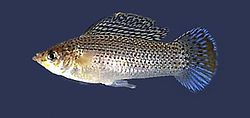User:Dysmorodrepanis~enwiki/Sandbox9
| Poecilia | |
|---|---|

| |
| Sailfin molly (Poecilia latipinna) | |
| Scientific classification | |
| Kingdom: | |
| Phylum: | |
| Class: | |
| Order: | |
| Family: | |
| Genus: | Poecilia |
| Species | |
|
See text. | |
| Synonyms | |
|
Acanthophacelus | |
Poecilia is a genus of freshwater fish in family Poeciliidae of order Cyprinodontiformes.[1] The type species is P. vivipara. Live-bearers, the Poecilia species are collectively known as mollies, with the exception of Endler's livebearer (P. wingei) and the famous guppy (P. reticulata). The family Poeciliidae, which also includes such well-known fishes as the southern platyfish or "platy" (Xiphophorus maculatus), and the green swordtail (X. hellerii).
IUCN list two of the species, the sulphur molly, P. sulphuraria, and the broadspotted molly, P. latipunctata, as Critically Endangered.
The generic name Poecilia derives from the Greek ποικίλος (variegated), in reference to the fishes' coloration.
Systematics
[edit]The genus Poecilia consist of several distinct lineages which are sometimes separated as distinct genera; the limias are most often considered separate. mtDNA NADH dehydrogenase subunit 2 sequence analysis has confirmed the monophyly of the assemblage. It remains debatable whether the genus should be split or kept united, but given the high morphological diversity between and homogeneity inside each lineage, it is probably better to consider the lineages as distinct genera.
This is supported by the fact that hybridization between members of any one lineage is not infrequent, in some cases - especially in captivity - even commonplace, and that offspring are usually fully fertile. Indeed, the amazon molly is an ancient hybrid population that has stabilized genetically so much that today it is considered a species in its own right. The (sub)genera on the other hand do not hybridize among each other to a notable extent. Thus, the biggest drawback of using mtDNA for phylogenetic studies - susceptibility of the data to hybridization events - may be a major problem when studying species' relationships, but does not overly affect delimitation of subgenera.(Breden et al. 1999)
FishBase (2006) lists 33 species, but its delimitation - apparently based on Rodriquez (1997) - makes the genus paraphyletic. It does not include Poecilia rositae which was recently separated (Meyer et al. 2004).
The group containing the guppy and its closest relatives is especially problematic as regards taxonomy and systematics. It apparently forms 2 clades, but the study of Breden et al. (1999) could not recover them with robust support. It may either consititute one (sub)genus Lebistes or Acanthophacelus[2]. Alternatively, Lebistes/Acanthophacelus could be limited to the guppy clade, and the other species could be separated as Micropoecilia. The latter group is often also considered a separate genus, but Breden et al. (1999) seems to argue quite strongly against this. Based on the presently available data, it seems as if making Micropoecilia a subgenus of a distinct genus Lebistes (or Acanthophacelus) would most appropriately reflect the phylogenetic reality.
Poecilia - southern mollies
[edit]- Poecilia amazonica Garman, 1895.
- Poecilia caucana (Steindachner, 1880).
- Poecilia vivipara Bloch & Schneider, 1801.
Mollienesia - northern mollies
[edit]- Pacific molly, Poecilia butleri Jordan, 1889.
- Catemaco molly, Poecilia catemaconis Miller, 1975.
- Amazon molly, Poecilia × formosa (Girard, 1859).
- Poecilia gillii (Kner, 1863).
- Sailfin molly, Poecilia latipinna (Lesueur, 1821).
- Broadspotted molly, Poecilia latipunctata Meek, 1904.
- Poecilia marcellinoi Poeser, 1995.
- Balsas molly, Poecilia maylandi Meyer, 1983.
- Shortfin molly, Poecilia mexicana Steindachner, 1863.
- Mangrove molly, Poecilia orri Fowler, 1943.
- Peten molly, Poecilia petenensis Günther, 1866.
- Poecilia rositae Meyer, Radda, Schartl, Schneider & Wilde, 2004.
- Poecilia salvatoris Regan, 1907.
- Molly, black molly Poecilia sphenops Valenciennes , 1846.
- Poecilia vandepolli Van Lidth de Jeude, 1887.
- Yucatan molly, Poecilia velifera (Regan, 1914).
Limia - limias
[edit]- See limia article. About 20 species; seems to contain 2 lineages: Limia group and Ondontolimia group.
Lebistes/Acanthophacelus - guppy and relatives
[edit]Lebistes/Acanthophacelus group
- Guppy, Poecilia reticulata Peters, 1859.
- Endler's livebearer, Poecilia wingei Isbrücker, Kempkes & Poeser, 2005.
Micropoecilia group
Pamphorichthys - Amazonian livebearers
[edit]N.N. - Venezuelan livebearers
[edit]- Poecilia boesemani Poeser, 2003.
- Poecilia caudofasciata (Regan, 1913).
- Dwarf molly, Poecilia chica Miller, 1975.
- Poecilia dauli Meyer & Radda, 2000.
- Elegant molly, Poecilia elegans (Trewavas, 1948).
- Hispaniola molly, Poecilia hispaniolana Rivas, 1978.
- Poecilia koperi Poeser, 2003.
- Poecilia kykesis Poeser, 2002.
- Poecilia mechthildae Bork, Etzel & Meyer, 2002.
- Poecilia nicholsi (Myers, 1931).
- Sulphur molly, Poecilia sulphuraria (Alvarez, 1948).
- Mountain molly, Poecilia teresae Greenfield, 1990.
- Poecilia wandae Poeser, 2003.
References
[edit]- Breden, Felix; Ptacek, Margaret B.; Rashed, Michael; Taphorn, Donald & Figueiredo, Carlos Augusto (1999): Molecular Phylogeny of the Live-Bearing Fish Genus Poecilia (Cyprinodontiformes: Poeciliidae). Molecular Phylogenetics and Evolution 12(2): 95–104. doi:10.1006/mpev.1998.0600 (HTML abstract)
- FishBase (2006): Poecilia. Ed. Ranier Froese and Daniel Pauly. May 2006 version. N.p.: FishBase, 2006.
- Meyer, Manfred K.; Radda, Alfred C.; Schartl, Manfred; Schneider, Klaus & Wilde, Brigitta (2004): A new species of Poecilia, subgenus Mollienesia, from upper río Cahabón system, Guatemala, with remarks on the Nomenclature of Mollienesia petenensis Günther, 1866 (Teleostei: Cyprinodontiformes: Poeciliidae). Zoologische Abhandlungen (Dresden) 54: 145–154. PDF fulltext
- Rodriquez, Carlos Ml. (1997): Phylogenetic analysis of the Tribe Poeciliini (Cyprinodontiformes: Poeciliidae). Copeia 1997(4): 663–679. doi:10.2307/1447285 (HTML abstract and first page image)
Footnotes
[edit]- ^ "Poecilia". Integrated Taxonomic Information System. June 8.
{{cite web}}: Check date values in:|date=and|year=/|date=mismatch (help) - ^ Owing to uncertainty whether the fish described as Lebistes poecilioides by de Filippi in 1861 were really guppies. If they were, Lebistes must be used due to being published first.
External links
[edit]- The Aquarium Wiki: Poecilia profiles.
